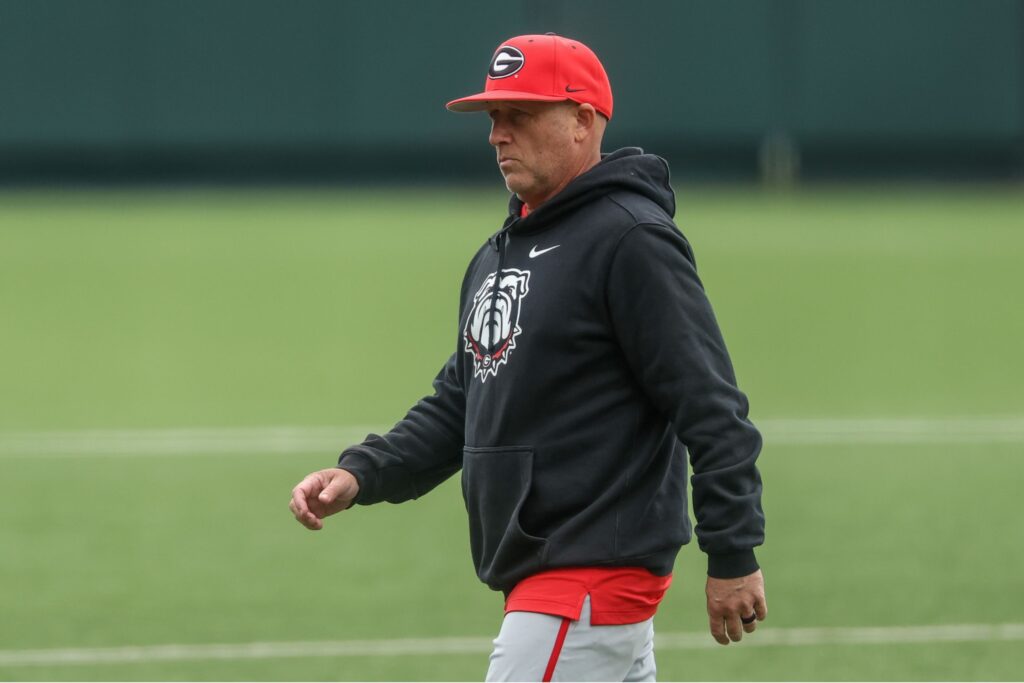Image credit:
Georgia coach Wes Johnson (Photo by David Buono/Icon Sportswire via Getty Images)
The calendar has flipped to September, which means that players and coaches are back at their respective college campuses and fall ball is on the horizon.
1. Georgia
Over the last few seasons, Georgia has proven it can navigate the portal as well as any team in the country. Things were no different in 2025—and it may have been the Bulldogs’ best transfer class yet. While Georgia hasn’t made the College World Series since 2008, this year’s portal class certainly gives coach Wes Johnson’s squad Omaha upside in 2026.
There’s plenty of talent to go around, but it’s hard to not focus on the standout arms the Bulldogs brought in. It starts with Joey Volchko (3-4, 6.01 ERA), who might have the best pure stuff in the 2026 draft class. He has an unbelievably live arm, yet command has been a bugaboo in each of his first two seasons. Fellow former Stanford righthander Matt Scott (5-2, 6.02 ERA) opted to head to Georgia for his senior season instead of turning pro, while Caden Aoki (6-4, 3.99 ERA)—one of the best, if not the best, strike-throwers in the country—is also expected to compete for a spot in the weekend rotation.
Those three arms are talented enough to make up a quality portal class on their own, yet Georgia also added a number of big-time bats. Two-way players Bryce Calloway (.390/.484/.722, 4.26 ERA) and Kenny Ishikawa (.318/.420/.562, 4.21 ERA) are in line to make an impact on both sides of the baseball, while Jack Arcamone (.355/.463/.675)—who also had plenty of draft interest—and Ryan Wynn (.331/.413/.492) give the Bulldogs two quality up-the-middle pieces.
In addition to its premier portal class, the ‘Dawgs also welcome a pair of high-level recruits to campus in Joe Nottingham (No. 159) and Ty Peeples (No. 192). How much of an impact they make in year one is yet to be seen, but Nottingham is a projection righthander who’s been up to 95 mph, while Peeples has flashed solid thump from the left side.
2. Mississippi State
Following the departure of Chris Lemonis, Mississippi State made a big-time splash this past June when it announced it would be hiring former Virginia head coach Brian O’Connor. O’Connor and his staff wasted no time getting to work and quickly put together one of the best portal classes in the country.
A number of O’Connor’s better players from Virginia—such as James Nunnallee (.296/.407/.401), Aidan Teel (.317/.442/.538) and Tomas Valincius (5-1, 4.59 ERA)—followed him to Starkville. There are also a number of non-former ‘Hoos who are cornerstones of this year’s portal class. Blake Bevis (.301/.369/.615), Vytas Valincius (.348/.434/.520)—brother of Tomas— and Drew Wyers (.407/.521/.710) all profile as key pieces offensively, while Tyler Pitzer (4-0, 6.99 ERA), who is fresh off taking home Cape Cod League pitcher of the year honors, Jackson Logar (4-5, 3.53 ERA) and Maddox Webb (4-1, 4.04 ERA) are all expected to log meaningful innings on the bump.
Led by lefty flamethrower Jack Bauer (No. 44), O’Connor and his staff also did a fantastic job of building out and maintaining a deep recruiting class. On top of Bauer, the Bulldogs will also welcome Jacob Parker (No. 116)—brother of No. 8 overall pick JoJo Parker—to campus, as well as Parker Rhodes (No. 200), Peter Mershon (No. 223) and Tanner Beliveau (No. 260). All five had heavy draft interest this past July, and now they’ll head to Starkville where they’ll look to make their mark over the next few seasons.
3. Tennessee
One thing college baseball fans can set their watches to every offseason is Tennessee putting together one of the most impressive newcomer classes of any team in the country. This year was no exception, as the Volunteers once again reloaded via the portal and will welcome a bevy of blue chip recruits to campus.
Their biggest fish was undoubtedly star outfielder Henry Ford (.362/.420/.575). Ford enjoyed an excellent spring and had legitimate top two-round interest in this year’s draft, but he instead will honor his commitment to Tennessee and head to Rocky Top. Former Bowling Green catcher Garrett Wright (.396/.506/.644) had one of the best seasons of any mid-major hitter in the country and will both catch and rove the outfield for the Volunteers, while Blaine Brown’s (.292/.362/.493) plus pullside power profiles nicely in the hitter-friendly confines of Lindsey Nelson Stadium.
Righthander Landon Mack (6-5, 4.03 ERA) is the headliner on the pitching side, though pitchability southpaw Evan Blanco (3-5, 6.23 ERA) will also compete for a weekend starting role. In the bullpen, sidewinder Brady Frederick (8-2, 2.67 ERA)—who was named the SoCon pitcher of the year—and Bo Rhudy (2-0, 3.16 ERA) have a chance to be two of the better relievers in the SEC.
Shifting gears to the prep side, Vitello and his staff have a number of freshmen at their disposal. Cameron Appenzeller (No. 52), a 6-foot-5 lefthander, has the highest ceiling of anyone in the group, while catcher Trent Grindlinger (No. 100) has a plus arm to go along with above-average raw power. Not to be outdone, Evan Hankins (No. 204) and Taylor Tracey (No. 265) both have plus power potential, while Tracey also has intriguing upside on the bump. Righthander Ethan Baiotto (No. 415) boasts a solid three-pitch mix, while backstop Cash Williams (No. 418) has a plus arm and fits the description of a “baseball rat.”
Tennessee is one of very few teams who fit in the “reload, not rebuild” bucket, and Vitello again has his squad positioned for a deep tournament run.
4. Virginia
In the wake of Brian O’Connor’s departure for Mississippi State, Virginia made a sizable splash of its own when it hired former Duke coach Chris Pollard.
While the meat of this year’s portal class is largely made up of former Blue Devils—especially potential top 10 pick AJ Gracia (.293/.449/.558) and Henry Zatkowski (5-2, 4.83 ERA)—there are a few additional quality pieces to keep a close eye on. Former Rider standout Joe Tiroly (.377/.481/.749) projects to slot into the middle of the order, while catcher Noah Jouras (.319/.444/.505) is expected to help fill the void behind the dish left by Jacob Ference. The biggest sleeper in Virginia’s crop of newcomers is lefthander Frank Willius (3-1, 2.76 ERA). A transfer from Division III California Lutheran, Willius this spring struck out 53 across 32.2 innings and features a fastball that’s been up to 94 mph along with a promising slider.
In what’s become the norm in Charlottesville, Virginia again has a fantastic recruiting class. Its headliners are a trio of big-time righthanders in Jayden Stroman (No. 132), Noah Yoder (No. 136) and John Paone, and each player has the stuff to make an immediate impact. On the other side of the baseball, outfielders William Mahala (No. 218) and Griffin Enis (No. 258) have exciting toolsets, while catcher Thomas O’Connell (No. 266) has an intriguing hit-power combination to go along with a solid defensive skillset.
Though Pollard has never coached a team to Omaha, that could change in rather short order thanks to this year’s crop of newcomers.
5. LSU
Over the course of the last few seasons, LSU has cemented itself as the top program in the sport. Under the guide of coach Jay Johnson and his staff, the Tigers have won two of the last three national championships and are one of the only teams in the country to have seemed to figure out the “wild west” transfer portal environment. On top of their portal success, LSU consistently puts together one of the best recruiting classes.
Starting with the former, a trio of sluggers in Trent Caraway (.267/.350/.470), Seth Dardar (.326/.429/.636) and Zach Yorke (.339/.447/.632) all figure to slide into prominent roles offensively. Johnson also went out and got a handful of intriguing arms who are in line to take on similarly important roles. Lefthanders Santi Garcia (3-0, 4.20 ERA) and Danny Lachenmayer (2-4, 3.37 ERA) both ranked inside the top 50 on this year’s top 100 transfers list, while former Kansas righthander Cooper Moore (7-3, 3.96 ERA) makes his way to campus after having his fair share of draft buzz.
LSU’s recruiting class this year is led by Omar Serna, an ultra-physical catcher who has plenty of raw power and serious arm strength to boot. Outfielder William Patrick (No. 95) provides an exciting blend of “now” tools, athleticism and physicality, while righthander Marcos Paz (No. 150)—even though he was on the shelf for much of the draft cycle after getting Tommy John Surgery—has flashed a fastball that’s been up to 96 mph to go along with a high-spin, mid-80s slider.
Only the best is the standard in Baton Rouge these days, and LSU has the talent to dog pile in Omaha for the third time in the last four years.
6. Auburn
Following a down year in 2024 in which it failed to make the tournament for the first time since 2019, Auburn returned to form last season and went back to a super regional for the first time since 2022. Rather than being a flash in the pan type of year, the Tigers—between their new and returning personnel—are well-positioned for a period of sustained success.
Auburn’s group of newcomers is led by lefthander Jake Marciano. While his ERA of 6.08 was unimpressive, he’s a far better pitcher and prospect than that number indicates. Across 14 starts that spanned 60.2 innings, he punched out 71 batters and walked just 18. As Marciano continues to fill out physically, his stuff figures to tick up across the board. Another arm who figures to compete for a spot in the Tigers’ weekend rotation is Drew Whalen. One of the cornerstones of Western Kentucky’s standout staff last spring, Whalen pitched to a 3.53 ERA with 90 strikeouts to 31 walks across a team-high 81.2 innings.
Offensively, infielder Ryne Farber was a two-year standout at Texas State and is in line to take the reins at shortstop. He has an advanced feel for the barrel, and his bat-to-ball skills are comfortably plus to go along with a polished approach and advanced swing decision. Farber’s instincts and baseball sense are off the charts, which help his tools play up on both sides of the baseball. Todd Clay (.361/.473/.539) and Eddie Madrigal (.368/.462/.698) are also primed for significant roles after enjoying standout seasons at UAB and St. Mary’s, respectively.
Incoming freshmen righthanders Justice De Jong (No. 146) and Ethin Bingaman (No. 165) have both flashed fastballs that have been up to 95 mph, while shortstop Ty Thompson (No. 257) has solid contact skills and is a plus runner who has a chance to stick at shortstop.
7. Florida State
The Seminoles were decimated by the draft and had a nation-leading 11 players selected, but coach Link Jarrett and his staff did an outstanding job of rebuilding the roster. On top of five top 100 transfers, FSU also has a solid recruiting class. Ranked as the No. 5 transfer in the country, lefthander Trey Beard is a potential top two-round draft pick who will compete for the Friday starter job. He pitched his way to a 3.14 ERA with an impressive strikeout-to-walk ratio of 118-to-32 across 86 innings. If it wasn’t for Charlotte righthander Blake Gillespie, Beard would have taken home AAC pitcher of the year honors.
Former Oregon fireballer Cole Stokes heads east to Tallahassee following a bounce-back 2025 campaign in which he pitched to a 3.10 ERA with an impressive 39 strikeouts across 20.1 innings (24 appearances). He has a plus fastball-slider combination with each offering generates plenty of empty swings. Another arm who figures to be one of the Seminoles’ most called-upon relievers is former Southern California righthander Brodie Purcell. Purcell was the Trojans’ most trusted bullpen arm last year, and across 42.2 innings (27 appearances), he compiled a 2.11 ERA with 51 strikeouts to 19 walks.
Gabe Nard was Duke’s go-to reliever this spring and across 29 appearances that spanned 50.2 innings, he compiled a 4.62 ERA with 45 strikeouts to 17 walks. He can be deployed in a number of roles—including as a starter—though he’s most effective in a bullpen role. Also joining is USC’s Brayden Dowd, who last year hit .324/.446/.524 with 15 doubles, 10 home runs, 36 RBIs and more walks (46) than strikeouts (43). The 5-foot-10 outfielder has a good-looking swing from the left side in which he has both bat and hand speed.
Florida State’s transfer class is deeper than its recruiting class, but keep an eye on John Stuetzer (No. 341) and Kelvyn Paulino Jr. (No. 461). Stuetzer was a high-level, multi-sport athlete in high school who’s a double-plus runner, while Paulino Jr. has solid bat speed with above-average raw power and the defensive skillset to potentially stick at third base.
8. Texas
Jim Schlossnagle’s first season in Austin was a success. He guided the Longhorns to a regular-season SEC title in the school’s first year in the conference en route to taking home the conference’s coach of the year award. While the Longhorns were bounced in their own regional, Schlossnagle and his staff wasted no time rebuilding their roster to set themselves up for a deeper run in 2026.
The big fish in Texas’ portal class is former Notre Dame backstop, Carson Tinney (.348/.498/.753). After logging just 56 at-bats as a freshman, Tinney enjoyed one of the biggest breakout campaigns of any hitter in the country this past spring. He has no-doubt plus power and an advanced defensive skillset, and he figures to be a high-impact player on both sides of the baseball. Outfielder Aiden Robbins enters the mix after hitting .422/.537/.652 slash line with 30 extra-base hits, 20 stolen bases and 44 walks to just 32 strikeouts. As a cherry on top to his standout spring, Robbins this summer was also the Cape Cod League’s batting champion.
On the hill, it will be exciting to see what lefthander Haiden Leffew (4-1, 4.46 ERA) is able to accomplish under the tutelage of pitching coach Max Weiner. He racked up 59 strikeouts across 34.1 innings this spring and his plus, low-80s kick-change generated an outlandish 72% miss rate.
Unsurprisingly, pitching is also the biggest strength of Texas’ recruiting class. Brody Walls (No. 160, Jack McKernan (No. 164), Brett Crossland (No. 180) and Cooper Rummel (No. 191) all ranked inside the top 200 on the final iteration of the BA 500, while outfielder Anthony Pack Jr. (No. 208) has impressive bat speed and an appealing blend of contact skills and plus speed.
9. Oklahoma
Coach Skip Johnson and the Sooners are fresh off another successful season that culminated in their fourth-straight tournament appearance. While the program has advanced to a super regional just once since 2013, it feels like Oklahoma is on the cusp of a return trip to the College World Series. Led by a fantastic portal class, the Sooners head into this fall with plenty of buzz.
Righthander LJ Mercurius (4-3, 3.57 ERA) makes his way east to Norman following a successful two-year stint at UNLV. After showing flashes as a freshman, Mercurius took a sizable step forward last season and compiled a 3.57 ERA with 58 strikeouts to 25 walks across 53 innings. Offensively, outfielder Nolan Stevens (.320/.414/.500) is a physical, lefthanded hitter who has shown the ability to back spin the baseball to all fields, particularly to the pull side, where he has plus power. A former pitcher, Stevens also has a plus arm. Perhaps the most exciting player in Oklahoma’s transfer haul, Camden Johnson (.325/.402/.433) is a top-of-the-order dynamo who’s turned in double-plus run times and is a plus athlete. He showed well at third base this summer and figures to man the hot corner for Oklahoma, though his speed and athleticism might profile best in center field professionally. Cayden Brumaugh’s (.309/.388/.451) skillset and versatility allow him to impact the game in myriad ways, while 6-foot-7 righthander Mason Bixby (1-0, 5.89 ERA) has flashed a mid-to-upper-90s fastball.
Oklahoma’s recruiting class doesn’t have the kind of depth that its transfer class does, but 6-foot-6 outfielder Alec Blair (No. 71) was one of the best pure athletes in the 2025 class. Blair’s power upside is immense, and his combination of speed and athleticism give him a chance to stick in center field, though he’s also slated to be a member of the Sooners’ basketball team. Righthander Vaughn Neckar has a stocky build and possesses a fastball that’s been up to 95 mph to go along with a pair of effective breaking balls.
Between its returning talent and group of newcomers, Oklahoma has the pieces to be playing well into June.
10. Arizona State
The Sun Devils last year made a regional for the first time since 2021 and had their most draft picks in a single season since 1981. Coach Willie Bloomquist and company had no shortage of talent at their disposal, but they entered the offseason knowing there would be gaping holes to replace on both sides of the baseball.
Offensively, outfielder Dean Toigo (.377/.445/.682) and shortstop P.J. Moutzouridis (.270/.329/.367) are the biggest names, though Dominic Longo (.305/.397/.535) and others also figure to compete for starting roles. While Ben Jacobs and Jack Martinez were both drafted, ASU returns a handful of exciting arms. In addition to their returners, the transfer trio of Kole Klecker (0-0, 4.66 ERA), Taylor Penn (3-1, 3.48 ERA) and Alex Overbay (4-2, 5.14 ERA) all project to step into prominent roles.
The Sun Devils’ recruiting class is led by shortstop Finn Leach (No. 268), a switch-hitting shortstop who has a balanced swing and generates plenty of hard line drive contact. Though he has hit tool questions, 6-foot-5 outfielder Hagen Wright’s raw power is immense. Arizona State this year will look to make a regional in consecutive seasons for the first time since 2019 and 2021.
Discover more from 6up.net
Subscribe to get the latest posts sent to your email.


